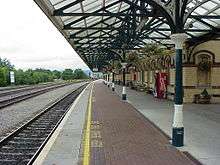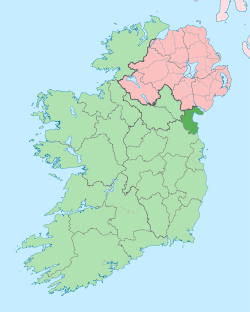Dundalk
Dundalk (/dʌnˈdɔːk/ dun-DAWK; Irish: Dún Dealgan [ˌd̪ˠuːnˠ ˈdʲalˠɡənˠ], meaning "Dalgan's fort")[7] is the county town of County Louth, Ireland. It is on the Castletown River, which flows into Dundalk Bay, and near the border with Northern Ireland, halfway between Dublin and Belfast. It has associations with the mythical warrior hero Cú Chulainn.

Dundalk Dún Dealgan | |
|---|---|
Town | |
 Clockwise from top: Castle Roche, Clarke Station, St. Patrick's Pro-Cathedral, The Marshes Shopping Centre, Market Square, Dundalk Institute of Technology | |
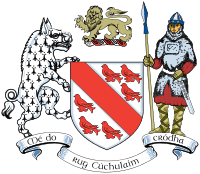 Coat of arms | |
| Motto(s): | |
 Dundalk Location in Ireland  Dundalk Dundalk (Europe) | |
| Coordinates: 54.009°N 6.4049°W | |
| Country | Ireland |
| Province | Leinster |
| County | County Louth |
| Dáil Éireann | Louth |
| EU Parliament | Midlands–North-West |
| Inhabited | 3500 BC[1][2][3] |
| Charter | 1189 |
| Area | |
| • Urban | 25.19 km2 (9.73 sq mi) |
| • Rural | 354.04 km2 (136.70 sq mi) |
| Population (Census 2016) | |
| • Rank | 8th |
| • Urban | 39,004[5] |
| • Metro | 55,806[6] |
| Time zone | UTC±0 (WET) |
| • Summer (DST) | UTC+1 (IST) |
| Eircode routing key | A91 |
| Telephone area code | +353(0)42 |
| Irish Grid Reference | J048074 |
| Website | www |
History
The Dundalk area has been inhabited since at least 3500 BC, during the Neolithic period. A tangible reminder of this early presence can still be seen in the form of the Proleek Dolmen, the eroded remains of a megalithic tomb in the Ballymascanlon area, north of Dundalk. Celtic culture arrived in Ireland around 500 BC. According to legendary historical accounts,[8] the group settled in North Louth were known as the Conaille Muirtheimne and took their name from Conaill Carnagh, chief of the Red Branch Knights of Ulster. Their land now forms upper and lower Dundalk.
Dundalk was originally developed as an unwalled Sráid Bhaile (literally "Street Townland", meaning "village"). The streets passed along a gravel ridge that runs from the present-day Bridge Street in the North, through Church Street to Clanbrassil Street to Earl Street, and finally to Dublin Street.
In 1169 the Normans arrived in Ireland and set about conquering large areas. By 1185 the Norman nobleman Bertram de Verdun erected a manor house at Castletown Mount and in 1189 obtained the town's charter. Another Norman family, the De Courcys, led by John de Courcy, settled in Dundalk's Seatown area, the "Nova Villa de Dundalke". Both families assisted in the town's fortification, building walls and other fortification in the style of a Norman fortress.[9] Dundalk was developed as it lay close to an easy bridging point over the Castletown River and as a frontier town, the northern limit of The Pale. In 1236 Bertram's granddaughter Rohesia commissioned Castle Roche to fortify the region, and to offer protection from the Irish territory of Ulster.[10]
The town was sacked in 1315, during the Bruce campaign.[11] After taking possession of the town Edward Bruce proclaimed himself King of Ireland and remained here for nearly a whole year before his army was totally defeated and himself slain after being attacked by John de Birmingham.
Dundalk had been under Royalist (Ormondist) control for centuries, until 1647 when it became occupied by The Northern Parliamentary Army of Colonel George Monck.[12]
| Historical population | ||
|---|---|---|
| Year | Pop. | ±% |
| 1821 | 9,256 | — |
| 1831 | 10,078 | +8.9% |
| 1841 | 10,782 | +7.0% |
| 1851 | 9,842 | −8.7% |
| 1861 | 10,360 | +5.3% |
| 1871 | 11,327 | +9.3% |
| 1881 | 11,913 | +5.2% |
| 1891 | 12,449 | +4.5% |
| 1901 | 13,076 | +5.0% |
| 1911 | 13,128 | +0.4% |
| 1926 | 13,996 | +6.6% |
| 1936 | 14,684 | +4.9% |
| 1946 | 18,562 | +26.4% |
| 1951 | 19,678 | +6.0% |
| 1956 | 21,687 | +10.2% |
| 1961 | 21,228 | −2.1% |
| 1966 | 21,678 | +2.1% |
| 1971 | 23,816 | +9.9% |
| 1981 | 29,135 | +22.3% |
| 1986 | 30,608 | +5.1% |
| 1991 | 30,061 | −1.8% |
| 1996 | 30,195 | +0.4% |
| 2002 | 32,505 | +7.7% |
| 2006 | 35,090 | +8.0% |
| 2011 | 37,816 | +7.8% |
| 2016 | 39,004 | +3.1% |
| [13][14][15][16][17] | ||
The modern town of Dundalk largely owes its form to Lord Limerick (James Hamilton, later 1st Earl of Clanbrassil) in the 17th century. He commissioned the construction of streets leading to the town centre; his ideas stemming from his visits to Continental Europe. In addition to the demolition of the old walls and castles, he had new roads laid out eastwards of the principal streets. The most important of these new roads connected a newly laid down Market Square, which still survives, with a linen and cambric factory at its eastern end, adjacent to what was once an army cavalry and artillery barracks (now Aiken Barracks).
In the 19th century, the town grew in importance and many industries were set up in the local area, including a large distillery. This development was helped considerably by the opening of railways, the expansion of the docks area or 'Quay' and the setting up of a board of commissioners to run the town.[18]
The partition of Ireland in May 1921 turned Dundalk into a border town and the Dublin–Belfast main line into an international railway. The Irish Free State opened customs and immigration facilities at Dundalk to check goods and passengers crossing the border by train. The Irish Civil War of 1922–23 saw a number of confrontations in Dundalk. The local Fourth Northern Division of the Irish Republican Army under Frank Aiken, who took over Dundalk barracks after the British left, tried to stay neutral but 300 of them were detained by the National Army in August 1922.[19] However, a raid on Dundalk Gaol freed Aiken and over 100 other anti-treaty prisoners;[20] two weeks later he retook Dundalk barracks and captured its garrison before freeing the remaining republican prisoners there. Aiken did not try to hold the town, however, and before withdrawing he called for a truce in a meeting in the centre of Dundalk. The 49 Infantry Battalion and 58 Infantry Battalion of the National Army were based in Dundalk along with No.8 armoured locomotive and two fully armoured cars of their Railway Protection Corps.
For several decades after the end of the Civil War, Dundalk continued to function as a market town, a regional centre, and a centre of administration and manufacturing. Its position close to the border gave it considerable significance during the "Troubles" of Northern Ireland. Many people were sympathetic to the cause of the Provisional Irish Republican Army and Sinn Féin. It was in this period that Dundalk earned the nickname 'El Paso', after the Texan border town of the same name on the border with Mexico.[2][21]
In December 2000, Minister for Foreign Affairs Brian Cowen welcomed US president Bill Clinton to Dundalk to mark the conclusion of the Troubles and the success of the Northern Ireland peace process. Cowen said:
Dundalk is a meeting point between Dublin and Belfast, and has played a central role in the origin and evolution of the peace process. More than most towns in our country, Dundalk, as a border town, has appreciated the need for a lasting and just peace.[22]
On 1 September 1973, the 27 Infantry Battalion of the Irish Army was established with its Headquarters in Dundalk barracks, renamed Aiken Barracks in 1986 in honour of Frank Aiken.
Dundalk suffered economically when Irish membership of the European Economic Community in the 1970s exposed local manufacturers to foreign competition that they were ill-equipped to cope with. The result was the closure of many local factories, resulting in the highest unemployment rate in Leinster, Ireland's richest province. High unemployment produced serious social problems in the town that were only alleviated by the advent of the Celtic Tiger investment boom at the start of the 21st century. Dundalk's economy has developed rapidly since 2000. Today many international companies have factories in Dundalk, from food processing to high-tech computer components. Harp Lager, a beer produced by Diageo, is brewed in the Great Northern Brewery, Dundalk.
The Earls of Roden[23] had property interests in Dundalk for over three centuries, and at an auction in July 2006 the 10th Earl sold his freehold of the town, including ground rents, mineral rights, manorial rights, the reversion of leases and the freehold of highways, common land, and the fair green. Included in the sale were many documents, such as a large 18th-century estate map. The buyer was undisclosed.[24]
Battles
- 248 – Battle fought at Faughart by Cormac Ulfada, High King of Ireland against Storno (Starno), king of Lochlin[25]
- 732 – Battle fought at Faughart by Hugh Allain, king of Ireland against the Ulaid[26]
- 851 – Battle at Dundalk Bay between the Fingall (Norwegian) and Dubhgall (Danish) Vikings takes place[27][28][29][30]
- 877 – Gregory, King of Scotland took Dundalk en route to Dublin[31]
- 1318 – Battle of Dundalk (Battle of Faughart) fought on 14 October 1318 between a Hiberno-Norman force led by John de Bermingham, 1st Earl of Louth and Edmund Butler, Earl of Carrick and a Scots-Irish army commanded by Edward Bruce, brother of Robert Bruce, King of Scotland.[32][33]
- 1483 – Traghbally-of-Dundalk plundered and burned by Hugh Oge ally of Con O'Donnell[34]
- 1566 – O'Neill besieged the town with 4,000 footmen and 700 horsemen[35]
- 1688 – Brothers Malcolm and Archibald MacNeill, officers of William III land in Dundalk and defeat the Celtic MacScanlons in the Battle of Ballymascanlon[36]
- 1689 – Schomberg's Williamite Army camped to the north of the town record 6,000 deaths due to fever, scurvy, and ague[37]
- 1941 – On 24 July the town was bombed by the Luftwaffe with no casualties.
- 1971 – The Battle of Courtbane – on Sunday 29 August 1971 a British army patrol consisting of two armoured Ferret Scout cars crossed the Irish border into Co. Louth near the village of Courtbane close to Dundalk. When attempting to retreat back angry locals blocked their way and set one of the vehicles on fire. While this was happening an IRA unit arrived on the scene and after an exchange of gunfire a British soldier was killed and another one was wounded.[38]
- 1975 – The Dundalk Christmas Bombing – on 19 December 1975 a car bomb killed 2 and injured 15[39][40]
Coat of arms
The Coat of Arms of Dundalk was officially granted by the Office of the Chief Herald at the National Library of Ireland in 1968, and is a replication of the Seal Matrix of the "New Town of Dundalk", which itself dates to the 14th Century.[41] A bend between six martlets forms the shield. The bend and martlets are derived from the family of Thomas de Furnivall,[42] who obtained a large part of the land and property of Dundalk and district in about 1309 by marriage to Joan de Verdon daughter of Theobald de Verdon (an Anglo-Norman family).[43] The ermine boar supporter is derived from the arms of the Ó hAnluain (O'Hanlon) family, Kings of Airthir. The origins of the foot soldier with his spear and sword is not known, neither is the lion on the crest, although the latter may be from the Mortimer family who held the Lordship of Louth in 1330. A Mortimer Castle stood in Park Street as late as the seventeenth century.
Prior to 1968, a simpler form of the seal – "three martlets proper on a blue field" – was used for the town's coat of arms, dating to when the town had been granted a charter in 1675.[44] It appears as the "Corporation Arms" in a town plan dated 1675.[45] This form of the Coat of Arms can be seen carved in stone on the Italianate Palazzo Town-hall, built between 1855 and 1865.[46] In 1930 the town council proposed to remove the "three black crows" from the seal of the town due to its English origins.[47] This coat of arms also became the crest of Dundalk Football Club in 1928, prior to the club severing its links with the Great Northern Railway (Ireland). The club's current crest retains three martlets on a red shield, as a nod to the town's granted Coat of Arms, but in reversed tinctures.
Geography
Landscape
Situated where the Castletown River flows into Dundalk Bay, the town is close to the border with Northern Ireland (3.5 km direct point-to-point aerial transit path border to border) and equidistant from Dublin and Belfast.
Climate
Similar to much of northwest Europe, Dundalk experiences a oceanic climate, sheltered by the Cooley and Mourne Mountains to the north, and undulating hills to the west and south, the town experiences cool winters, quite warm summers, and a lack of temperature extremes.
| Climate data for Dundalk, Leinster | |||||||||||||
|---|---|---|---|---|---|---|---|---|---|---|---|---|---|
| Month | Jan | Feb | Mar | Apr | May | Jun | Jul | Aug | Sep | Oct | Nov | Dec | Year |
| Average high °C (°F) | 7.2 (45.0) |
7.5 (45.5) |
9.5 (49.1) |
11.8 (53.2) |
14.8 (58.6) |
17.6 (63.7) |
19 (66) |
18.7 (65.7) |
16.6 (61.9) |
13.6 (56.5) |
9.6 (49.3) |
8 (46) |
12.8 (55.0) |
| Average low °C (°F) | 1.7 (35.1) |
1.8 (35.2) |
2.7 (36.9) |
3.9 (39.0) |
6.5 (43.7) |
9.3 (48.7) |
11.1 (52.0) |
10.8 (51.4) |
9.3 (48.7) |
7.2 (45.0) |
3.7 (38.7) |
2.7 (36.9) |
5.9 (42.6) |
| Average precipitation mm (inches) | 85 (3.3) |
62 (2.4) |
66 (2.6) |
56 (2.2) |
62 (2.4) |
63 (2.5) |
66 (2.6) |
84 (3.3) |
84 (3.3) |
87 (3.4) |
81 (3.2) |
93 (3.7) |
889 (34.9) |
| Source: Dundalk climate | |||||||||||||
Demographics
Population by place of birth:
| Location | 2006[48] | 2011[49] | 2016[50] | Change |
|---|---|---|---|---|
| Ireland | 28,095 | 29,114 | 29,430 | +316 |
| UK | 3,488 | 3,839 | 3,791 | −48 |
| Poland | 252 | 555 | 602 | +47 |
| Lithuania | 421 | 633 | 657 | +24 |
| Other EU 28 | 692 | 1,119 | 1,508 | +389 |
| Rest of World | 1,804 | 2,269 | 2,652 | +383 |
Population by ethnic or cultural background:
| Ethnicity or culture | 2006[48] | 2011[51] | 2016[52] |
|---|---|---|---|
| White Irish | 29,840 | 30,645 | 29,872 |
| White Irish Traveller | 325 | 441 | 535 |
| Other White | 1,802 | 2,987 | 3,572 |
| Black or Black Irish | 1,276 | 1,669 | 1,785 |
| Asian or Asian Irish | 372 | 687 | 988 |
| Other | 380 | 389 | 682 |
| Not stated | 757 | 711 | 1,206 |
Population by religion:
| Religion | 2002[53] | 2006[48] | 2011[54] | 2016[55] |
|---|---|---|---|---|
| Roman Catholic | 29,177 | 30,677 | 31,790 | 30,187 |
| Church of Ireland (incl. Protestant) | 482 | 527 | – | – |
| Church of Ireland, England, Anglican, Episcopalian | – | – | 590 | – |
| Apostolic or Pentecostal | – | – | 359 | – |
| Other Christian religion, n.e.s. | 415 | 480 | 714 | – |
| Presbyterian | 169 | 165 | 178 | – |
| Muslim (Islamic) | 279 | 436 | 569 | – |
| Orthodox (Greek, Coptic, Russian) | 44 | 171 | 399 | – |
| Methodist, Wesleyan | 84 | 66 | – | – |
| Other stated religions | 467 | 627 | 541 | 4,248 |
| No religion | 773 | 1,158 | 1,971 | 3,331 |
| Not stated | 615 | 778 | 705 | 1,238 |
Places of interest
Places of interest in North Louth within 15 km of Dundalk.
| Place | Description | Location | Image |
|---|---|---|---|
| County Museum Dundalk | The county museum documenting the history of County Louth. | 54°0′16.79″N 6°23′49.75″W | |
| St. Patrick's Church[56] | The site was acquired in 1834 with the building completed in 1847, but was in use from 1842. | 54°0′13.94″N 6°23′56.8″W | |
| St. Nicholas' Church (Roman Catholic)[56] | The site was levelled and the foundations cleared out in February 1859, dedication of the Church was in August 1860. Contains a shrine to the local born St. Bridget. | 54°0′35.03″N 6°24′9.1″W | |
| St Joseph's Redemptorist Church[57] | The community of Redemptorists, or missionary priests, settled here in 1876.[58] Contains a relic of St. Gerard Majella. | 54°0′15.2″N 6°23′21.8″W | |
| Parish Church of Saint Nicholas (Anglican Church of Ireland) | Known locally as the Green Church due to its green copper spire. Contains epitaph erected to the memory of Scotland's National Bard, Robert Burns and whose sister Agnes Burns/Galt and her husband William Galt who built Stephenstown Pond are buried here.[59] | 54°0′30.53″N 6°24′5.81″W | 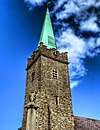 |
| Priory of St Malachy, Dominican chapel | The 'Carlingford Dominicans' official foundation in Dundalk was in 1777[60] | 54°0′1.69″N 6°24′31.09″W | |
| Saint Brigid's Shrine[61][62] | 54°3′11.3″N 6°23′53.24″W | ||
| St Brigid's Well | Holy Well dedicated to St. Brigid | 54°3′6.09″N 6°23′2.06″W | |
| St Bridget's Church, Kilcurry | Holds a relic of St Bridget – a fragment of her skull was brought here in 1905 by Sister Mary Agnes of the Dundalk Convent of Mercy | 54°2′33.57″N 6°25′31.99″W | |
| Castle Roche | Norman castle, the seat of the De Verdun family, who built the castle in 1236 AD. | 54°2′47″N 6°29′18″W |  |
| Proleek Dolmen[63] | One of the finest examples of its kind in Ireland | 54°2′13.86″N 6°20′53.75″W | |
| Proleek Wedge Tomb | 54°2′12.84″N 6°20′49.88″W | ||
| Franciscan friary | Founded 1246[64] | 54°0′22.51″N 6°23′37.92″W |  |
| Windmill Tower | An eight-storey windmill-tower, built around 1800. | 54°0′21.14″N 6°23′21.22″W | |
| Our Lady's Well / Ladywell | Pattern takes place here on 15 August, during the feast of the assumption. | 53°59′36.91″N 6°24′8.23″W | |
| Cloghafarmore (Cuchulains / Cú Chulainn Stone) | Standing stone on which Cú Chulainn tied himself to after his battle with Lugaid in order to die on his feet, facing his enemies. | 53.974484°N 6.465991°W | 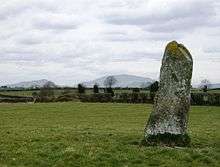 |
| Dromiskin Round Tower & High Crosses | Founded by a disciple of St Patrick, Lughaidh (unknown – 515AD) | 53°55′19.24″N 6°23′53.55″W | |
| Cú Chulainn Castle / Dun Dealgan Castle / Castletown Motte / Byrne's Folly | Built in the late 11th century by Bertram de Verdun, a later addition was the castellated house known as 'Byrne's Folly' built in 1780 by a local pirate named Patrick Byrne. | 54°0′49.77″N 6°25′48.82″W | 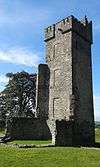 |
| Magic Hill | A place where the layout of the surrounding land produces the optical illusion that a very slight downhill slope appears to be an uphill slope. Thus, a car left out of gear will appear to be rolling uphill against gravity.[65] | 54°1′19.6″N 6°17′31.86″W | |
| Long Woman's Grave or "The Cairn of Cauthleen" | The grave of a Spanish noble woman, Cauthleen, who married Lorcan O’Hanlon, the youngest son of the "Cean" or Chieftain of Omeath.[66] Her grave is known as the "Lug Bhan Fada" (long woman's hollow).[66] | 54°3′40.63″N 6°16′28.85″W | |
| Rockmarshall Court Tomb | 14 metres long cairn. | 54°0′33″N 6°17′5″W | |
| Dunmahon Castle | Ruins of four storeys tower-house with vault over ground floor. In 1659 it was the residence of Henry Townley. | 53°57′27.48″N 6°25′19.4″W | |
| Haynestown castle | 3-storey square tower house with corner turrets | 53°57′36.47″N 6°24′40.85″W | |
| Milltown Castle | 15th-century Norman keep about 55 feet high built by the Gernon family. | 53°55′58.77″N 6°25′34.23″W | |
| Knockabbey Castle and Gardens | Originally built in 1399, the historical water gardens originally date from the 11th century. | 53°55′47.61″N 6°35′7.01″W | |
| Louth Hall Castle | Ruins originally built in the 14th century in gothic design, it was later extended in the 18th and 19th century in Georgian design. Home of the Plunkett family, Lords of Louth | 53°54′44.01″N 6°33′11.56″W | |
| Roodstown Castle | Dates from the 15th century, features two turrets. | 53°52′20.11″N 6°29′12.07″W | |
| Aghnaskeagh Cairn and Portal Tomb | 54°3′40.59″N 6°21′28.6″W | ||
| Faughart Round Tower | Remains of a monastery founded by St Moninna in the 5th century. | 54°3′6.11″N 6°23′4.18″W | |
| Grave of Edward Bruce | Proclaimed High King of Ireland before he was killed in the battle of Faughart in 1318 | 54°3′6.11″N 6°23′4.18″W | |
| Faughart Motte | 54°3′8.07″N 6°23′9.67″W | ||
| Kilwirra Church, Templetown | St Mary's Church at Templetown, associated with the Knights Templar founded in 1118 by Hugh de Payens. | 53°59′10.33″N 6°9′18.51″W | |
| Lady Well, Templetown | 53°59′14.74″N 6°9′10.79″W | ||
| Ardee Castle | The largest fortified medieval Tower House in Ireland or Britain, founded by Roger de Peppard in 1207, the current building was built in the 15th century by John St. Ledger. James II used it as his headquarters for a month prior to the Battle of the Boyne. | 53°51′18.43″N 6°32′19.7″W | |
| Hatch's Castle, Ardee | Medieval Tower House | 53°51′24.99″N 6°32′22.22″W | |
| Kildemock Church 'The Jumping Church' | 14th-century church built on the site of the Church of Deomog (Cill Deomog), under the control of the Knights Templar until 1540. | 53°50′8.96″N 6°31′14.28″W | |
| St Mary's Priory | Augustinian Priory stands on the site where St Mochta established a monastery in 528 CE. | 53°57′11.68″N 6°32′38.97″W | |
| St Mochta's House | 12th Century Church/Oratory. | 53°57′12.33″N 6°32′43.36″W | |
| St James' Well | 54°1′11.03″N 6°8′38.83″W | ||
| Liberties of Carlingford | Medieval Head Carving | 54°2′31.47″N 6°11′13.81″W | |
| The Mint of Carlingford | Mint established in 1467 | 54°2′25.06″N 6°11′11.02″W | |
| Tallanstown Motte | 53°55′15.12″N 6°32′59.53″W | ||
| Dominican Priory of Carlingford | Founded by Richard de Burgh in 1305 | 54°2′17.33″N 6°11′4.13″W | |
| King John's Castle (Carlingford) | Commissioned by Hugh de Lacy before 1186, the castle owes its name to King John (Richard the Lionheart's brother) who visited Carlingford in 1210. | 54°2′35.7″N 6°11′12.3″W |  |
| Carlingford Lough | A glacial fjord that forms part of the border between Northern Ireland to the north and Ireland to the south. On its northern shore is County Down and on its southern shore is County Louth. At its extreme interior angle (the northwest corner) it is fed by the Newry River and the Newry Canal. | 54°2′35.7″N 6°11′12.3″W | 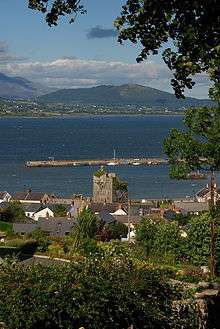 |
| Ravensdale Forest, Ravensdale, County Louth | 54°03′08″N 6°20′23″W | 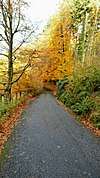 |
Festivals and culture
Music and arts
Dundalk has two photography clubs, Dundalk Photographic Society[67] and the Tain Photographic Club. In 2010 Dundalk Photographic Society won the FIAP Photography Club World Cup.[68]
Musical groups and organisations include the Fr. McNally Chamber Orchestra (which was created in April 2010),[69] and the Cross Border Orchestra of Ireland (CBOI) which is a youth orchestra based in the Dundalk Institute of Technology.[70] The latter maintains a membership of 160 musicians between the ages of 12 and 24 and was established in 1995 shortly after the implementation of the Peace Process. It tours regularly to Europe and America and has sold out venues such as Carnegie Hall and Chicago Symphony Hall. The Clermont Chorale[71] was formed in 2003 and has 30 members, drawn from different parts of County Louth. Dundalk School of Music was created in 2010 and provides education in music for different ages and disciplines.[72]
Dundalk Gaol is the home of The Oriel Centre, a regional centre for Comhaltas Ceoltoirí Éireann.[73] It opened in 2010 and promotes traditional Irish music, song, dance and the Irish language.
Festivals
Festivals associated with Dundalk include the Brigid of Faughart Festival in February,[61] and the Carlingford National Leprechaun Hunt which is held in March.[74]
The Táin March festival, established in 2011, is a walking festival which seeks to commemorate the legendary Cattle Raid of Cooley (Táin Bó Cúailnge).[75] It is held in June, as is the Dundalk Youth Arts Festival.
In August, the All-Ireland Poc Fada Championship is held. Other events in the late summer and early Autumn include the Peninsula Ploughing & Field Day, Greenore Maritime Festival, the Knockbridge Vintage Rally & Family Fun Day,[76] and Saint Gerard Majella Novena[77]
The Dundalk Festival of Light & Culture and Ardee Baroque Festival are held over the winter period.[78]
Transport
Shipping services to Liverpool were provided from 1837 by the Dundalk Steam Packet Company.
Dundalk is an important stop along the Dublin–Belfast railway line, being the last station on the Republic side of the border. Its rail link to Dublin was inaugurated in 1849 and the line to Belfast was opened the following year. Further railway links opened to Derry by 1859 and Greenore in 1873.
In the 20th century, Dundalk's secondary railway links were closed: first the line to Greenore in 1951 and then that to Derry in 1957. In 1966 Dundalk railway station was renamed Dundalk Clarke Station after the Irish republican activist Tom Clarke, though it is still usually just called Dundalk Station. The station is served by the Dublin-Belfast "Enterprise" express trains as well as local Commuter services to and from Dublin. It also houses a small museum of railway history. Dundalk is the last train station on the line before crossing the border into Northern Ireland.
Dundalk's Bus Station is operated by Bus Éireann and located at Long Walk near the town centre.
Major infrastructure upgrades have taken place in and around Dundalk. These improvements have covered the road, rail and telecommunication infrastructures for—according to the National Development Plan—a better integration with the neighbouring Dublin, Midlands Gateway, and Cavan/Monaghan Hubs.
The M1 – N1/A1 connects Dundalk to Dublin and Newry. Works to extend it to Belfast were completed in July 2010.
Education
Primary education
Primary schools in Dundalk include a number of Irish language-medium schools (Gaelscoileanna) like Gaelscoil Dhún Dealgan.[79] There are approximately 20 English-medium national schools in the area, the largest of which include Muire na nGael National School (also known as Bay Estate National School) and Saint Joseph's National School, which (as of early 2020) had an enrollment of over 670 and 570 pupils respectively.[80][81][82]
Secondary schools
Secondary schools in the town include Coláiste Lú (an Irish medium secondary school or Gaelcholáiste),[83] De la Salle College, Dundalk Grammar School, St. Mary's College (also known as the Marist), O'Fiaich College,[84] Coláiste Rís, St. Vincent's Secondary School,[85] St. Louis Secondary School, and Coláiste Chú Chulainn.[86]

Tertiary education
Dundalk Institute of Technology (often abbreviated to DkIT) is the primary higher education provider in the north east of the country. It was established in 1970 as the Regional Technical College, offering primarily technician and apprenticeship courses.
The Ó Fiaich Institute of Further Education also offers further education courses.[87]
Media
The local newspapers are The Argus, Dundalk Democrat and Dundalk Leader.[88]
Online only media outlet includes Talk of the Town.[89]
The local radio station is Dundalk FM broadcasting on 97.7 FM,[90] with regional stations LMFM (Louth-Meath FM) on 96.5 FM, and iRadio (NE and Midlands) on 106.2FM also covering the area. UK Services from nearby Northern Ireland can also be clearly received.
Sport
Association football
Dundalk Football Club (/dʌnˈdɔːk/; Irish: Cumann Peile Dhún Dealgan) is a professional association football club. The club competes in the League of Ireland Premier Division, the top tier of Irish football, and are the reigning League Champions and League of Ireland Cup holders. Founded in 1903 as the works-team of the Great Northern Railway, they played in junior competition until joining the Leinster Senior League in 1922. After playing four seasons at that level, they were elected to the Free State League (which later became the League of Ireland) on 15 June 1926. They became the first club outside of Dublin to win the league title in 1932–33, and have won at least one league title or FAI Cup in every decade since. They are now the second most successful club in the League's history, and the most successful in the Premier Division era. The club has played at Oriel Park since moving from its original home at the Dundalk Athletic Grounds in 1936.
Rugby
Dundalk R.F.C. was formed in 1877 and has achieved a number of honours over its history. These include winning the Provincial Towns Cup on 10 occasions from 15 appearances. Dundalk is currently in the Leinster League Division 1A and field three senior teams plus youth and mini teams at all age groups, and a number of girls' tag teams.[91]
Ice hockey
The Dundalk Ice Dome (closed as of August 2012) was where local ice hockey team the Dundalk Bulls (now defunct) played. The Ice Dome hosted the IIHF World Championship of Division III in April 2007.[92]
Horse racing and greyhound racing
Both horse racing and greyhound racing are held at Dundalk Stadium. Ireland's first all-weather horse racing track was opened in August 2007 on the site of the old Dundalk racecourse.[93] The course held Ireland's first ever meeting under floodlights on 27 September 2007.
American football
Louth's only American Football team, the Louth Mavericks American Football Club[94] (Formerly Dundalk Mavericks), are based in Dundalk and were set up in 2012. They currently play in AFI Division 1. The club train at DKIT and play their matches at Dundalk Rugby Club. 2017 was the club's most successful year, going 5–3 and defeating the Craigavon Cowboys in the IAFL1 Bowl[95] to gain promotion to the top division for the first time in the club's history.[96]
Tennis
Dundalk also has a tennis club, The Dundalk Lawn Tennis and Badminton Club[97] was founded in 1913 and held the Senior Interprovincial Championships (inter-pros) on 29–31 August 2010.[98]
Cricket
Dundalk Cricket Club was founded in November 2009 and began playing matches in the 2010 season.[99] It was recognised by the cricket magazine The Wisden Cricketer as its "Club of the Month" for October 2010. This is both unusual for an Irish club and a club only twelve months into its existence. In 2011, the club was admitted into the Leinster Cricket Union and played in Leinster Senior League Division 11. In the 2011 season it won the Leinster League Division 11 Championship title and in the course of doing so became the only club in the whole of Leinster across the 14 divisions to go unbeaten. In the 2012 season the club won their second title as Leinster League Division 9 Champions.
Snooker
Dundalk & District Snooker League has been running for over 20 years. In 2010 the league was re-branded as the Dundalk Snooker League sponsored, by Tool-Fix. The league has attracted national recognition through RIBSA (Republic of Ireland Snooker and Billiards Association) and the CYMS Letterkenny, who have arranged a "ryder cup" style challenge match against the best players in the Dundalk Snooker League. As of the 2012 season, the league had 15 teams and 113 players competing in 6 championship events, 4 ranking events and 5 special events.[100]
Cycling
The first cycling club in Dundalk was founded in 1874. Cuchulainn Cycling Club[101] was formed in 1935 and is currently one of the biggest and most active cycling clubs in the country with over 300 members. The club caters for all disciplines of the sport including road, off-road and BMX. The club has acquired permission for the construction of a cycling park and 250m velodrome in Muirhevna Mor.[102]
Other sports
Dundalk Kayak Club, founded in 2005, operates from their clubhouse just outside Dundalk town. They cater for all levels of kayaker and run beginner courses twice yearly.
Dundalk held its first ever national fencing tournament in April 2007.[103]
Dundalk also has a basketball team, the Dundalk Ravens.
Gaelic football
Dundalk Gaels GFC (founded 1928) and Seán O'Mahony's GFC (founded 1938) both represent the town.
Politics and government
Louth County Council (Irish: Comhairle Contae Lú), County Hall, Millennium Centre, Dundalk[104] is the authority responsible for local government in Dundalk. As a county council, it is governed by the Local Government Act 2001. The council is responsible for housing and community, roads and transportation, urban planning and development, amenity and culture, and environment.[105] The council has 29 elected members, 13 of whom are from the Dundalk region. Elections are held every five years and are by single transferable vote.
For the purpose of elections the town is divided into two local electoral areas: Dundalk-Carlingford (6 Seats) and Dundalk South (7 Seats).[106]
Dundalk is represented in Dáil Éireann by the Louth parliamentary constituency.
Notable people
Arts and Media
- Peadar Ó Dubhda, Patriot, musician, politician, musician, and author of the first translation the Bible into Irish.[107][108]
- Paul Vincent Carroll (1900–1968), playwright who founded two theater groups in Glasgow, Scotland
- The Corrs, Celtic folk rock group and family (Andrea, Sharon, Caroline, and Jim Corr), born and raised in Dundalk
- Maria Cuche, singer who represented Ireland in the 1985 Eurovision Song Contest, finishing 6th
- The Flaws, indie rock band
- Catherine Gaskin (1929–2009), romance novelist
- Donald Macardle (1900–1984), actor, screenwriter, and director
- Dorothy Macardle (1889–1958), revolutionary, author and playwright
- Cathy Maguire, singer-songwriter; currently lives in the United States
- Dawn Martin, singer who represented Ireland in the 1998 Eurovision concert, finishing 9th
- Patrick McDonnell, actor in Naked Camera and Father Ted
- John Moore, film director, producer, and writer
- Brendan O'Dowda (1925–2002), Irish tenor who popularised the songs of Percy French
- Liam Reilly, singer who represented Ireland in the 1990 Eurovision Song Contest, finishing 2nd; singer in the group Bagatelle
- Jinx Lennon, Music Artist
- Thomas MacAnna (1926–2011), Tony Award-winning theatre director and playwright
- Molly Barton (1861-1949), artist
- Úna-Minh Kavanagh (born 1991), journalist and writer currently living in Dundalk
- Nuala Kennedy (1977–Present), artist
- Just Mustard (est. 2016), music group
Academia and Science
- Nicholas Callan, scientist who made the first induction coil; went to primary school here
- Thomas Coulter (1793–1843), botanist and doctor
- Richard FitzRalph (c. 1300 – 16 December 1360), Vice-Chancellor of the University of Oxford; Archbishop of Armagh from 1346 to 1360; his remains are interred at St Nicholas's Church
- John Phillip Holland, inventor of the submarine, worked as a teacher in Colaiste Ris, Dundalk
- Peter Kerley, radiologist known for describing Kerley lines of heart failure
- Peter Rice (1935–1992), engineer, worked on the Sydney Opera House, Louvre Pyramid and Centre Pompidou
- Laurie Winkless, physicist and science writer
- Fred Halliday, (1946–2010) writer and academic.
Politics
- Gerry Adams, Teachta Dála (TD) for Louth-Dundalk constituency since 2011
- Dermot Ahern, Fianna Fáil TD and former government minister
- Edward Haughey (1944–2014), entrepreneur and politician
- Brendan McGahon, former Fine Gael TD
Religion
- Saint Brigit of Kildare (c. 453 – c. 524)
Sport
- Tommy Byrne, former Formula 1 racing driver
- David Kearney, rugby player
- Rob Kearney, rugby player, current player for both Leinster and Ireland
- Jim McQuillan, Irish international darts player
- Steve Staunton, former football player and former Republic of Ireland national football team manager
- Tom Sharkey (1873–1953), heavyweight boxer
- Tommy Traynor (1933–2006), former footballer, Republic of Ireland national football team and Southampton FC left-back
Military
- Cú Chulainn, aka Sétanta
- Francis Leopold McClintock, Royal Navy Rear Admiral, Arctic explorer, discoverer of the fate of Franklin
Business
- Larry Goodman, entrepreneur in the beef industry. #22 on the Irish Independent Rich List 2017.[109]
- Dr Pearse Lyons, entrepreneur; President of Kentucky-based Alltech Inc.; proposed the sister cities twinning with the City of Pikeville, Kentucky. #5 on the Irish Independent Rich List 2017.[109]
- Henry McShane, established the McShane Bell Foundry; namesake of Dundalk, Maryland.
- Martin Naughton, entrepreneur founded GlenDimplex. #11 on the Irish Independent Rich List 2017.[109]
Other
- Agnes Burns, sister of the poet Robert Burns lived at Stephenstown with her husband William Galt between 1817 and 1834.
Twin towns and sister cities
Dundalk is twinned with the following places:


See also
- List of abbeys and priories in County Louth
- List of towns and villages in Ireland
- Dundalk, which existed until the Act of Union in 1800
- Dundalk, which existed 1801–1885
References
- "Dundalk - Carlingford and Mourne".
- "Dundalk". 20 March 2009.
- "eOceanic". www.inyourfootsteps.com.
- "Census 2011 – Population Classified by Area Table 6 – Population and area of each Province, County, City, urban area, rural area and Electoral Division, 2011 and 2006" (PDF). Census 2011, Volume 1 – Population Classified by Area. Central Statistics Office. 25 April 2012. p. 13. Archived from the original (PDF) on 14 November 2013. Retrieved 17 February 2014.
- "Settlement Dundalk". Central Statistics Office. 2016. Retrieved 2 June 2018.
- "Municipal District Dundalk". Central Statistics Office. 2016. Retrieved 22 December 2018.
- "Dún Dealgan/Dundalk". Logainm.ie.
- "Lebor Gabála Érenn". Oxford University Press. 1 January 2000. Retrieved 22 May 2012.
- Archiseek: The Architecture of Ireland. History of the Castle.
- Scoil Phádraig Naofa Kilcurry, County Louth, Ireland
- "Dundalk". www.libraryireland.com.
- O'Sullivan, Harold (1 January 1977). "The Cromwellian and Restoration Settlements in the Civil Parish of Dundalk, 1649 to 1673". Journal of the County Louth Archaeological and Historical Society. 19 (1): 24–58. doi:10.2307/27729438. JSTOR 27729438.
- Census for post 1821 figures. Archived 20 September 2010 at the Wayback Machine
- Archived 7 May 2016 at the Wayback Machine
- NISRA – Northern Ireland Statistics and Research Agency (c) 2013 Archived 17 February 2012 at the Wayback Machine. Nisranew.nisra.gov.uk (27 September 2010). Retrieved on 23 July 2013.
- Lee, JJ (1981). "On the accuracy of the Pre-famine Irish censuses". In Goldstrom, J. M.; Clarkson, L. A. (eds.). Irish Population, Economy, and Society: Essays in Honour of the Late K. H. Connell. Oxford, England: Clarendon Press.
- Mokyr, Joel; O Grada, Cormac (November 1984). "New Developments in Irish Population History, 1700–1850". The Economic History Review. 37 (4): 473–488. doi:10.1111/j.1468-0289.1984.tb00344.x. hdl:10197/1406. Archived from the original on 4 December 2012.
- Systems, Adlib Information. "Internet Server 3.1.1". www.louthcoco.ie.
- Joseph Gavin and Harol O'Sullivan. Dundalk: A Military History. (Dundalk: Dundalgan Press Ltd., 1987), pp.109–137.
- Dundalk Gaol interpretive centre Archived 27 September 2013 at the Wayback Machine website
- "Dundalk locals win the battle to keep the economy of the town they love so well alive".
- Cowen, Brian (12 December 2000). Speaking in Dundalk at a public event with President Clinton (Speech). Dundalk, Ireland: Department of the Taoiseach. Retrieved 30 October 2018.
- Dundalk Digital Atlas | Earls of Roden, from the Jocelyn family Archived 2 February 2016 at the Wayback Machine
- Fiona Gartland, "Freehold of Dundalk sold at auction" in The Irish Times dated 22 July 2006
- D'Alton, John (1864). The history of Dundalk and Its Environs: From the Earliest Historic Period to the present time. William Tempest. pp. 8.
- D'Alton, John (1864). The history of Dundalk and Its Environs: From the Earliest Historic Period to the present time. William Tempest. pp. 10.
- D'Alton, John (1845). The history of Ireland: from the earliest period to the year 1245, Vol II. Published by the author. p. 148.
- Donnchadha, Pádraig Mac (8 June 2010). "History of Vikings in Ireland".
- "RootsWeb.com Home Page". www.rootsweb.ancestry.com.
- "The Munster Army at the Battle of Dundalk". www.libraryireland.com.
- D'Alton, John (1864). The history of Dundalk and Its Environs: From the Earliest Historic Period to the present time. William Tempest. pp. 12.
- D'Alton, John (1845). The history of Ireland: from the earliest period to the year 1245, Vol II. Published by the author. p. 49.
- "Battle of Dundalk, 14 October 1318". www.historyofwar.org.
- D'Alton, John (1864). The history of Dundalk and Its Environs: From the Earliest Historic Period to the present time. William Tempest. pp. 88.
- D'Alton, John (1864). The history of Dundalk and Its Environs: From the Earliest Historic Period to the present time. William Tempest. pp. 110.
- D'Alton, John (1864). The history of Dundalk and Its Environs: From the Earliest Historic Period to the present time. William Tempest. pp. 310.
- D'Alton, John (1864). The history of Dundalk and Its Environs: From the Earliest Historic Period to the present time. William Tempest. pp. 174.
- "Battle of Courtbane attracts world media - Independent.ie".
- "Dundalk bombing report, Ludlow murder expected in few weeks - Independent.ie".
- "Home Page: The Dundalk Bombing, 19 December 1975". www.michael.donegan.care4free.net.
- "Coat of Arms (crest) of Dundalk". www.heraldry-wiki.com. Retrieved 23 June 2019.
- Flood, W. H. Grattan (29 March 1899). "The De Verdons of Louth". The Journal of the Royal Society of Antiquaries of Ireland. 9 (4): 417–419. JSTOR 25507007.
- "Heraldry of the world - Category:Irish municipalities". www.ngw.nl. Archived from the original on 8 October 2017. Retrieved 18 February 2017.
- "Dundalk's 1675 Seal". Evening Herald. 21 December 1938. Retrieved 26 September 2019.
- D’Alton, John (1864). The History of Dundalk, and its environs; from the earliest period to the present time; with memoirs of its eminent men. Charleston SC, U.S.A.: British Library Historical Print Editions. p. 299.
- "Town Hall, Crowe Street, Dundalk, County Louth". buildingsofireland.ie. National Inventory of Architectural Heritage. Retrieved 27 September 2019.
- "Three Black Crows". Belfast Newsletter. 19 December 1930. Retrieved 26 September 2019.
- "Dundalk Migration, Ethnicity and Religion (CSO Area Code LT 10008)". Central Statistics Office. 2006.
- "Dundalk Migration, Ethnicity and Religion (CSO Area Code LT 10008)". Central Statistics Office. 2011. Archived from the original on 29 October 2014.
- "Dundalk Migration, Ethnicity, Religion and Foreign Languages". Central Statistics Office. 2017.
- "Dundalk Migration, Ethnicity and Religion (CSO Area Code LT 10008)". Central Statistics Office. 2011. Archived from the original on 29 October 2014.
- "Usually resident population by ethnic or cultural background". Central Statistics Office. 2017.
- "Number of persons by religion (XLS 43KB), Row 147". Central Statistics Office. 2002.
- "Dundalk Migration, Ethnicity and Religion (CSO Area Code LT 10008)". Central Statistics Office. 2011. Archived from the original on 29 October 2014.
- "Population by religion". Central Statistics Office. 2017.
- "HISTORY". www.stpatricksparishdundalk.org.
- "About Us – St Joseph's Redemptorists Monastery". www.redemptoristsdundalk.ie.
- Tibus, Website design and development by. "St Joseph's Redemptorist Church - Attractions - Churches, Abbeys and Monasteries - All Ireland - Republic of Ireland - Louth - Dundalk - Discover Ireland". www.discoverireland.ie.
- "Robert Burns & the Louth connection". www.irishidentity.com.
- Priory of St Malachy, Dundalk | History
- "Home - Brigid of Faughart Festival - www.brigidoffaughart.ie". Brigid of Faughart.
- Tibus, Website design and development by. "Saint Brigid's Shrine and Well Faughart - Attractions - Churches, Abbeys and Monasteries - All Ireland - Republic of Ireland - Louth - Dundalk - Discover Ireland". www.discoverireland.ie.
- Tibus, Website design and development by. "Proleek Dolmen - Attractions - Museums and Attractions - All Ireland - Republic of Ireland - Louth - Dundalk - Discover Ireland". www.discoverireland.ie.
- Franciscan friary Archived 27 February 2015 at the Wayback Machine
- "Can Things Roll Uphill?". math.ucr.edu.
- "Archived copy". Archived from the original on 27 March 2015. Retrieved 6 March 2015.CS1 maint: archived copy as title (link)
- "Welcome to Dundalk Photographic Society". www.dundalkphoto.com.
- FIAP 5th Club World Cup Results Page Archived 21 December 2010 at the Wayback Machine
- "Fr. McNally Chamber Orchestra". www.facebook.com.
- The Cross Border Orchestra of Ireland Archived 5 September 2011 at the Wayback Machine
- "Clermont Chorale". www.facebook.com.
- Dundalk School of Music Archived 2 March 2011 at the Wayback Machine
- Home – Oriel Centre. Orielcentre.ie. Retrieved on 23 July 2013.
- "Carlingford & Cooley Peninsula - Official Destination Website". Carlingford & Cooley Peninsula.
- "Home - The Táin March Festival - Ireland's Ancient East". www.tainmarch.ie.
- "Knockbridge Vintage Club – Our Club Website". www.knockbridgevintageclub.com.
- "St Gerard's Novena gets underway in Dundalk this Sunday - Talk of the Town". Talk of the Town. 7 October 2017. Retrieved 10 September 2018.
- "Programme for Ardee Baroque 2012 – Create Louth". www.createlouth.ie.
- Gaelscoil Dhún Dealgan Archived 29 November 2007 at the Wayback Machine
- https://www.education.ie/en/Find-a-School/School-List/?level=Primary&geo=Louthðos=-1&lang=-1&gender=-1
- https://www.education.ie/en/find-a-school/School-Detail/?roll=19598V
- https://www.education.ie/en/find-a-school/School-Detail/?roll=19673J
- Coláiste Lú
- "O'Fiaich College, Secondary School".
- "St. Vincent's Secondary School".
- "Home". colaistecc.ie.
- "O Fiaich Institute of Further Education Dundalk". www.ofi.ie.
- "Dundalk Leader". www.dundalkleader.com.
- "Talk of the Town - News from Dundalk and north Louth". Talk of the Town.
- "Dundalk FM » Dundalk's Local Community Radio Station". Dundalk FM.
- "Dundalk Rugby Football Club". Archived from the original on 2 December 2013. Retrieved 27 November 2013.
- AG, Novanet Internet Consulting. "2007 IIHF World Championship Div III". www.iihf.com.
- RTE – 2007 Irish Racing Archived 4 May 2008 at the Wayback Machine
- "Louth Mavericks AFC". www.facebook.com.
- Match Report
- "Dundalk Lawn Tennis and Badminton Club". www.dundalkracketsclub.com.
- Welcome to Dundalk Lawn Tennis and Badminton club. Dundalkracketsclub.com. Retrieved on 23 July 2013.
- Dundalk Cricket Club home page Archived 9 October 2010 at the Wayback Machine. Dundalkcricketclub.com. Retrieved on 23 July 2013.
- Dundalk Snooker League Archived 25 March 2012 at the Wayback Machine. Dundalk Snooker League. Retrieved on 23 July 2013.
- "Cuchulainn Cycling Club - Catering for all Cyclists in Louth". www.dundalkcycling.com.
- "Archived copy". Archived from the original on 12 September 2017. Retrieved 27 January 2019.CS1 maint: archived copy as title (link)
- Dundalk Institute of Technology | Sport>
- "Home - Louth County Council". www.louthcoco.ie.
- "Services". Louth County Council. Retrieved 31 March 2011.
- "2014 Local elections – Louth County Council". ElectionsIreland.org. Retrieved 5 June 2014.
- "State of Dundalk great's grave a source of anger and embarrassment". www.dundalkdemocrat.ie. Retrieved 1 June 2020.
- "Town lost one of its most distinguished sons with death of novelist, playwright and musician, Peadar O'Dubhda". independent. Retrieved 1 June 2020.
- "Rich List 2017". Irish Independent. Retrieved 14 January 2018.
- Dundalk – Reze twinning page Archived 30 September 2007 at the Wayback Machine
- "Dundalk agrees to twin with Pikeville, Kentucky - Independent.ie".
